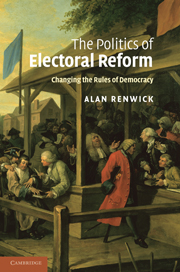Book contents
- Frontmatter
- Contents
- List of tables
- List of figures
- List of abbreviations
- Acknowledgements
- 1 Introduction
- PART I Building blocks
- PART II Elite majority imposition
- 5 France: the recurrent game of electoral reform
- 6 Italy: the search for stability
- 7 Japan: the persistence of SNTV
- 8 Elite majority imposition: comparative analysis
- PART III Elite–mass interaction
- Appendix: glossary of electoral system terminology
- Bibliography
- Index
6 - Italy: the search for stability
Published online by Cambridge University Press: 04 May 2010
- Frontmatter
- Contents
- List of tables
- List of figures
- List of abbreviations
- Acknowledgements
- 1 Introduction
- PART I Building blocks
- PART II Elite majority imposition
- 5 France: the recurrent game of electoral reform
- 6 Italy: the search for stability
- 7 Japan: the persistence of SNTV
- 8 Elite majority imposition: comparative analysis
- PART III Elite–mass interaction
- Appendix: glossary of electoral system terminology
- Bibliography
- Index
Summary
Italy does not quite share France's record of electoral system instability. Nevertheless, it does rank among those countries that have seen frequent changes: five major electoral reforms have occurred since the Second World War. One of these changes – the adoption of a semi-compensatory mixed system in 1993 – falls into the category of elite–mass interaction and is therefore discussed in Part III. In this chapter, I narrate the events of the remaining reform episodes: the re-establishment of proportional representation after Fascism and world war in 1946; the adoption of a bonus-adjusted system in 1953; the rapid abandonment of that system and restoration of PR in 1954; and the creation of a somewhat different bonus-adjusted system in 2005. I also outline the failure of intense reformist pressure between 1994 and 2001 and, briefly, the failure of a referendum on electoral reform in 2009. Table 6.1 provides an overview.
The origins of proportional representation
Proportional representation was first introduced in Italy, as in many other European countries, in 1919, following the end of the First World War. It was supported by all reformist forces, who hoped it ‘would sweep away the corrupt personalised politics of [pre-war] Giolittismo and substitute a struggle of principle between disciplined mass parties’ (Seton-Watson 1967: 514). But the new system was used in only two elections: Mussolini gained the premiership in 1922, and in 1923 intimidated parliament into passing a new electoral law.
- Type
- Chapter
- Information
- The Politics of Electoral ReformChanging the Rules of Democracy, pp. 111 - 128Publisher: Cambridge University PressPrint publication year: 2010



